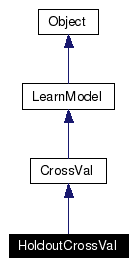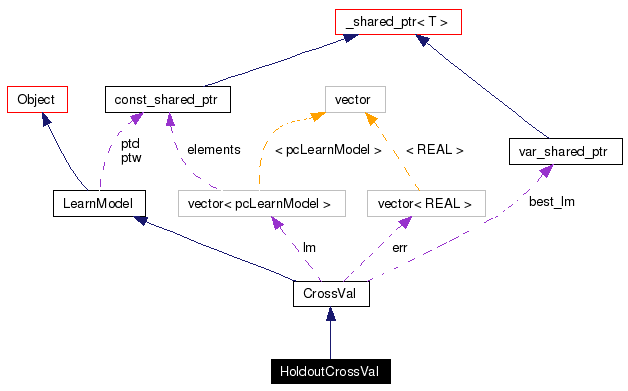
#include <crossval.h>
Inheritance diagram for HoldoutCrossVal:


Public Member Functions | |
| HoldoutCrossVal (REAL p=1.0/6, UINT r=0) | |
| HoldoutCrossVal (std::istream &is) | |
| virtual const id_t & | id () const |
| virtual HoldoutCrossVal * | create () const |
| Create a new object using the default constructor. | |
| virtual HoldoutCrossVal * | clone () const |
| Create a new object by replicating itself. | |
| REAL | holdout () const |
| void | set_holdout (REAL p, UINT r=0) |
| set the holdout portion and optionally set the number of rounds | |
Protected Member Functions | |
| virtual std::vector< REAL > | cv_round () const |
| one round of the cross-validation operation | |
| virtual bool | serialize (std::ostream &, ver_list &) const |
| virtual bool | unserialize (std::istream &, ver_list &, const id_t &=NIL_ID) |
Protected Attributes | |
| REAL | p_test |
Definition at line 118 of file crossval.h.
|
||||||||||||
|
Definition at line 120 of file crossval.h. References HoldoutCrossVal::set_holdout(). Referenced by HoldoutCrossVal::clone(), and HoldoutCrossVal::create(). |
|
|
Definition at line 121 of file crossval.h. |
|
|
Create a new object by replicating itself.
return new Derived(*this);
Implements CrossVal. Definition at line 125 of file crossval.h. References HoldoutCrossVal::HoldoutCrossVal(). |
|
|
Create a new object using the default constructor. The code for a derived class Derived is always return new Derived(); Implements CrossVal. Definition at line 124 of file crossval.h. References HoldoutCrossVal::HoldoutCrossVal(). |
|
|
one round of the cross-validation operation
Implements CrossVal. Definition at line 203 of file crossval.cpp. References dataset::append(), HoldoutCrossVal::p_test, LearnModel::ptd, and randu. |
|
|
Definition at line 128 of file crossval.h. References HoldoutCrossVal::p_test. |
|
|
Implements Object. |
|
||||||||||||
|
Reimplemented from CrossVal. Definition at line 190 of file crossval.cpp. References HoldoutCrossVal::p_test, and SERIALIZE_PARENT. |
|
||||||||||||
|
set the holdout portion and optionally set the number of rounds
Definition at line 130 of file crossval.h. References HoldoutCrossVal::p_test, and CrossVal::set_rounds(). Referenced by HoldoutCrossVal::HoldoutCrossVal(). |
|
||||||||||||||||
|
Reimplemented from CrossVal. Definition at line 196 of file crossval.cpp. References Object::NIL_ID, HoldoutCrossVal::p_test, and UNSERIALIZE_PARENT. |
|
|
Definition at line 136 of file crossval.h. Referenced by HoldoutCrossVal::cv_round(), HoldoutCrossVal::holdout(), HoldoutCrossVal::serialize(), HoldoutCrossVal::set_holdout(), and HoldoutCrossVal::unserialize(). |
 1.4.6
1.4.6